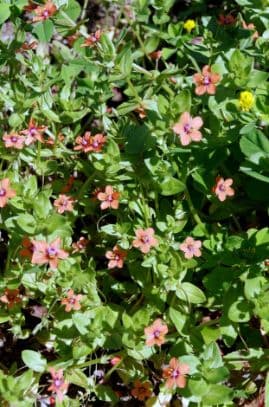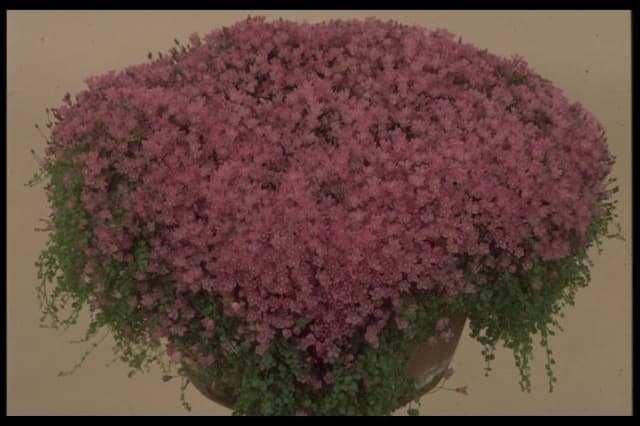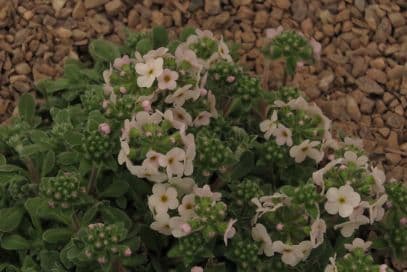Auricula Primula auricula 'Remus' (Au/s)

ABOUT
Primula auricula 'Remus', more commonly known as "auricula" or "bear's ear," is a perennial plant beloved for its ornate and striking appearance. This variety showcases a rosette of fleshy, rounded leaves that have a subtle dusting of powdery white, giving them a soft, velvety texture. The leaves are generally a rich green color, contributing to a lush presentation at the base of the plant. The auricula 'Remus' is particularly admired for its flowers, which are a mesmerizing display of colors and form. The blooms emerge on slender stalks, rising above the foliage to present themselves. Each flower is a work of art, often with multiple colors in a single bloom. The petals exhibit vivid hues, ranging from deep maroon or purples at the edges, graduating to a lighter shade or even a contrasting color towards the center. The center of the flower is marked by a distinctive, usually yellow or lighter colored "eye," which adds an extra pop of contrast against the darker petals. The combination of the unique foliage and stunning flowers makes the Primula auricula 'Remus' a cherished addition to any garden, often used to create a focal point or to add a splash of refined color to alpine and rock gardens. The beauty of this plant lies not only in its individual features but also in the way it presents itself as a whole – an elegant and sophisticated ornamental plant.
About this plant
 Names
NamesSynonyms
Auricula, Mountain Cowslip, Bear's Ear
Common names
Primula auricula 'Remus' (Au/s).
 Characteristics
CharacteristicsLife cycle
Perennials
Foliage type
Evergreen
Color of leaves
Green
Flower color
Mixed
Height
8 inches (20 cm)
Spread
8 inches (20 cm)
Plant type
Herb
Hardiness zones
5
Native area
Europe
Benefits
 General Benefits
General Benefits- Ornamental Appeal: Primula auricula 'Remus' adds visual interest to gardens with its striking flowers and rosette-forming foliage.
- Compact Growth: Suitable for small gardens, rockeries, or borders due to its compact growth habit.
- Spring Bloomer: Provides early-season color in the garden when many other plants are not yet in bloom.
- Low Maintenance: Requires minimal care once established, making it a good choice for busy gardeners.
- Diverse Planting Options: Can be grown in containers, alpine troughs, or directly in the garden soil, offering versatility in landscaping uses.
- Pollinator Friendly: Attracts bees and butterflies, which are important for pollination and the health of the ecosystem.
- Cold Hardy: Able to withstand cooler temperatures, making it suitable for gardens in cooler climates.
- Propagation: Can be easily propagated from offsets, allowing gardeners to expand their collection or share with others.
- Long Blooming: Often has a lengthy flowering period from late winter through to late spring.
- Breeding Cultivar: As a selected cultivar, 'Remus' has been bred for specific desirable traits, such as flower form and color.
 Medical Properties
Medical PropertiesThis plant is not used for medical purposes.
 Air-purifying Qualities
Air-purifying QualitiesThis plant is not specifically known for air purifying qualities.
 Other Uses
Other Uses- Auricula Theater Display: Auricula 'Remus' is commonly displayed in traditional auricula theaters, which are special shelving units designed to showcase the beauty of these plants.
- Photography Subject: The unique coloring and form of Auricula 'Remus' makes it an attractive subject for garden photographers and plant enthusiasts.
- Edible Flowers: The blossoms of Auricula 'Remus' can be used as edible decorations for cakes and desserts, adding a splash of color and a mild, floral flavor.
- Bee Attraction: Auricula 'Remus' flowers can attract bees to the garden, which helps with pollination of other plants and supports the local ecosystem.
- Theater and Art Inspiration: The distinctive appearance of Auricula 'Remus' has inspired artists and set designers who require botanical elements for visual impact.
- Botanical Studies: Auricula 'Remus' can be used as a study specimen for horticultural students and plant enthusiasts to learn about plant structure and hybrids.
- Fairy Gardens: The small size of Auricula 'Remus' makes it an ideal plant for creating fairy gardens, miniature landscapes designed to spark imagination.
- Crafting: Dried Auricula 'Remus' flowers can be used in crafting projects, such as pressed flower art or inclusion in homemade paper or candles.
- Companion Planting: Auricula 'Remus' can be used in companion planting to create visually striking contrasts with its unique coloration among other garden plants.
- Winter Garden Interest: As a hardy plant, Auricula 'Remus' can provide color and interest in the garden during the cooler months when many other plants have died back.
Interesting Facts
 Feng Shui
Feng ShuiThe Auricula is not used in Feng Shui practice.
 Zodiac Sign Compitability
Zodiac Sign CompitabilityThe Auricula is not used in astrology practice.
 Plant Symbolism
Plant Symbolism- Unwavering Affection: The Primula auricula, also known as "Auricula", is often associated with constancy and everlasting love, signifying deep attachment that stands the test of time.
- Precision and Uniqueness: The intricate patterns and vivid colors of Auricula blossoms represent a sense of meticulousness and the celebration of one's unique traits.
- Patience and Care: As Auriculas require careful tending, particularly when grown by auricula enthusiasts, they symbolize the patience and dedication invested in nurturing relationships or projects.
- Admiration and Pride: Historically, Auriculas were highly prized by florists and breeders, symbolizing admiration for beauty and pride in horticultural accomplishments.
- Overcoming Challenges: The ability of Auriculas to thrive in alpine conditions reflects resilience and the theme of overcoming difficulties with grace.
 Water
WaterBear's Ear should be watered regularly but allow the soil to dry out slightly between waterings to avoid waterlogging. In general, water once every week with about 16 ounces of water, but this can vary depending on the humidity and temperature. During the growing season in spring and summer, they may need more frequent watering, especially if they are outside and the weather is hot. In winter, reduce watering as the plant goes into dormancy. It's important to water at the base of the plant, avoiding getting water on the leaves or the center of the rosette to prevent rot.
 Light
LightBear's Ear thrives best in bright, indirect sunlight. The ideal spot would be near a window that receives plenty of light but is shielded from the direct rays of the sun, especially during the harsh midday hours. An east or west-facing window usually provides the optimal lighting conditions for this plant.
 Temperature
TemperatureBear's Ear prefers cooler conditions and does well in temperatures between 50°F and 75°F. It is important to protect the plant from extreme temperatures; it should not be exposed to temperatures below 32°F as this could be harmful. Ideally, keeping the plant in a consistently cool environment with good airflow will promote its health and flowering.
 Pruning
PruningPrune Bear's Ear to remove dead or fading flowers and encourage a more compact growth habit. Pruning is typically done after the flowering season, which is generally in early summer. By cutting back the spent flower stems and any dead foliage, you'll stimulate new growth and help maintain the plant's attractive appearance.
 Cleaning
CleaningAs needed
 Soil
SoilThe best soil mix for Auricula Primrose (the most common name of Primula auricula 'Remus') is a well-draining, loamy, and gritty mix with good organic content. The soil pH should be slightly acidic to neutral, ideally between 6.0 to 7.0. A mix of one part each of loam, peat, and coarse perlite or grit is recommended to ensure good drainage and aeration.
 Repotting
RepottingAuricula Primroses should be repotted every year or two to refresh the soil and accommodate root growth. It's best to repot them after they have finished flowering in the spring or summer, ensuring they are settled before the cooler weather.
 Humidity & Misting
Humidity & MistingAuricula Primroses thrive in moderate levels of humidity, around 50-60%. They prefer consistent moisture in the air but do not do well in overly wet or misty conditions that can promote fungal diseases.
 Suitable locations
Suitable locationsIndoor
Provide bright light; avoid water on leaves, cool temperatures preferred.
Outdoor
Plant in partial shade, shelter from rain, and well-draining soil.
Hardiness zone
4-8 USDA
 Life cycle
Life cycleThe life of the Auricula Primrose (Primula auricula 'Remus') begins with seed germination, which occurs in a moist, well-draining medium under cool conditions, typically in spring or autumn. Following germination, the seedlings develop into rosette-forming juveniles, with their unique foliage appearing as they mature. The plant then enters the vegetative stage, during which it grows and establishes a strong root system. After a period of vegetative growth, the Auricula Primrose reaches maturity and enters the flowering stage, usually in early spring, producing its characteristic, brightly colored flowers that attract pollinators. Once pollination has occurred, the flowers develop into seed pods, and when mature, these pods release seeds, thus completing the cycle. The Auricula Primrose is a perennial plant and this cycle can repeat for several years, with the plant going through periods of dormancy in the winter.
 Propogation
PropogationPropogation time
Spring-Early Summer
The Primula auricula 'Remus', commonly known as Auricula Primrose, is typically propagated through division, which is the most popular method. The ideal time for this process is after the plant has finished flowering, which usually occurs in late spring to early summer. To propagate by division, carefully remove the plant from its pot or garden location and brush off excess soil to reveal the root structure. Look for natural divisions in the plant and gently separate them, ensuring that each new section has a good amount of roots attached. Replant the divisions into pots filled with a mixture of peat and perlite or a well-draining soil mix to encourage healthy root growth. After replanting, water the divisions thoroughly to help reduce transplant shock and settle them into their new locations. It's essential to keep the soil consistently moist but not waterlogged, allowing the newly propagated Auriculas to establish.









